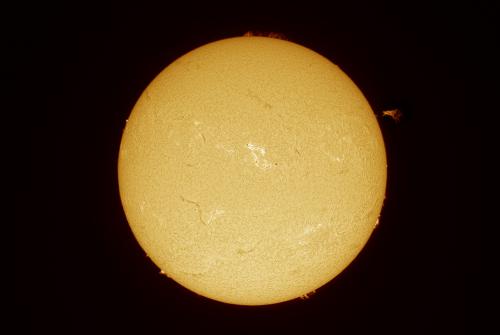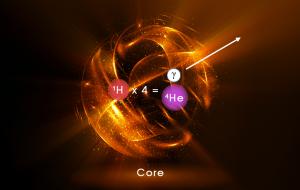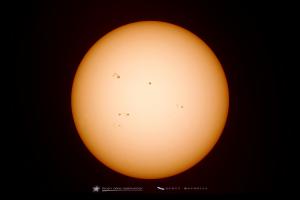Celebration of Space - Friday, May 10, 2024
This past week, a huge sunspot group rotated onto the side of the Sun that faces Earth. The group is designated AR 3664, and is large enough to be seen with your leftover eclipse glasses from the April 8th solar eclipse. When sunspots are on the side of the Sun facing Earth, we call them Earth-facing sunspots (duh!). During this time any flare events, associated with the sunspot group, could send a Coronal Mass Ejection (CME) towards Earth, which in turn could spark the fabled Northern Lights at lower latitudes. Let’s address what all these terms mean and how they work together.
In the core of the Sun hydrogen is fusing into helium. The process is called the Proton-Proton Chain, which we won’t go into here. Energy is released during this process in the form of a gamma ray, which will pass through the radiation zones above the core. Once outside of the radiation zone, convective currents in the form of granules (little pieces of solar material) in the convection zone will carry this energy to the solar photosphere, where they release the energy, and sink back down. The photosphere is what we see when we look at the Sun with eclipse glasses. This process takes upwards of 100,000 years, during which the gamma ray loses a significant amount of energy, and has shifted into visible light.
Sunspots form when granules carrying energy connect with other granules on the photosphere. The Sun is in the plasma state, so granules are dipolar, meaning they have a N and S magnetic pole. During the more active period of the Sun’s 11 year solar cycle, a higher rate of granules are rising, and they end up connecting to each other on the photosphere. When this happens they will form an independent magnetic field over them, which shields them from the surrounding radiation of the photosphere, which will allow them to cool. The photosphere is about 11,000ºF, but sunspots are around 6,000ºF. The difference in temperature is why sunspots appear dark. Though under the sunspot group, granules are backing up and trying to reach the photosphere to release their energy. The result is that the sunspot group, and magnetic field, start to break apart. Once the magnetic field fails, all this energy is released abruptly, as well as a significant magnetic push on the chromosphere and corona, which both sit over the photosphere. The failure of the sunspot group’s integrity is called a solar flare. The solar flare will expel a significant amount of plasma into the solar wind. Plasma that would have otherwise fallen back to the Sun. The plasma that is now traveling with the solar wind is called a CME.
If an Earth-facing sunspot group results in a flare, any resulting CME will be directed towards Earth. The CME will have two components, a radio blackout – which arrives at Earth in 8.5 minutes, followed by the geomagnetic storm – which will arrive at Earth in 2-4 days time. When the charged particles of the CME arrive at Earth, they will interact with Earth’s magnetic field. Initially, the movement of the particles in the solar wind will pull Earth’s magnetic field with it, exposing more of Earth’s atmosphere to the solar wind on the side of Earth facing the Sun. Secondly, some of these charged particles will follow Earth’s magnetic field lines towards the magnetic poles. Upon entering the ionosphere and the higher density of Earth’s lower atmospheric layers, the particles will strike oxygen and nitrogen atoms in our atmosphere, ionizing them. The resulting free flowing electrons will recombine with other ions which will put the atom into an excited state. When returning to a ground state, the atom will release some energy in the form of a photon (light). That light is the Aurora Borealis, and the different colors are associated with the different elements that are being ionized.
Sunspot group AR 3664 has been Earth-facing for the past week, and during that time has experienced a significant number of flaring events. These events have released a total of six CME events directed at Earth. The first CME arrived this afternoon, which dragged Earth’s magnetic field with it, exposing Earth’s atmosphere to the solar wind on the side of Earth facing the Sun. When the next several CME’s arrive, they will encounter much more of Earth’s atmosphere and have a high probability of triggering the Aurora Borealis over Southern New England. Timings are difficult to predict, and the first two CME’s arrived earlier than expected. Regardless, tonight is a good night to try to catch a view.
The rule is easy to understand: Don’t drive south to see the Northern lights. This makes Ninigret Park and Frosty Drew Observatory an unfavorable destination to see the Aurora. Instead, head north. Weather for tonight is questionable, though during the early morning hours the sky will clear over many areas in Southern New England. Keep in mind, the further north you go, the better the view will be. Let us know if you see the Aurora.
Now that the International Space Station (ISS) has commenced visible passes for every 90 minutes from dusk to dawn, opportunities to catch a stunning view of humanity’s only space-based residency passing over abound! You could view every single pass, and it would probably be worth it, but we will list only the best evening passes here.
Fri, May 10 at 10:13 pm, starting in the WSW, rising to 45º, heading towards the NE
Sat, May 11 at 9:23 pm, starting in the WSW, rising to 77º, heading towards the NE ← Awesome pass!
Sun, May 12 at 8:34 pm, starting in the SW, rising to 60º, heading towards the ENE ← Awesome pass!
Mon, May 13 at 9:22 pm, starting in the W, rising to 34º, heading towards the NE
Tue, May 14 at 8:32 pm, starting in the W, rising to 34º, heading towards the NE
Get out there and see some space!
- Author:
- Scott MacNeill
- Entry Date:
- May 10, 2024
- Published Under:
- Scott MacNeill's Columns





